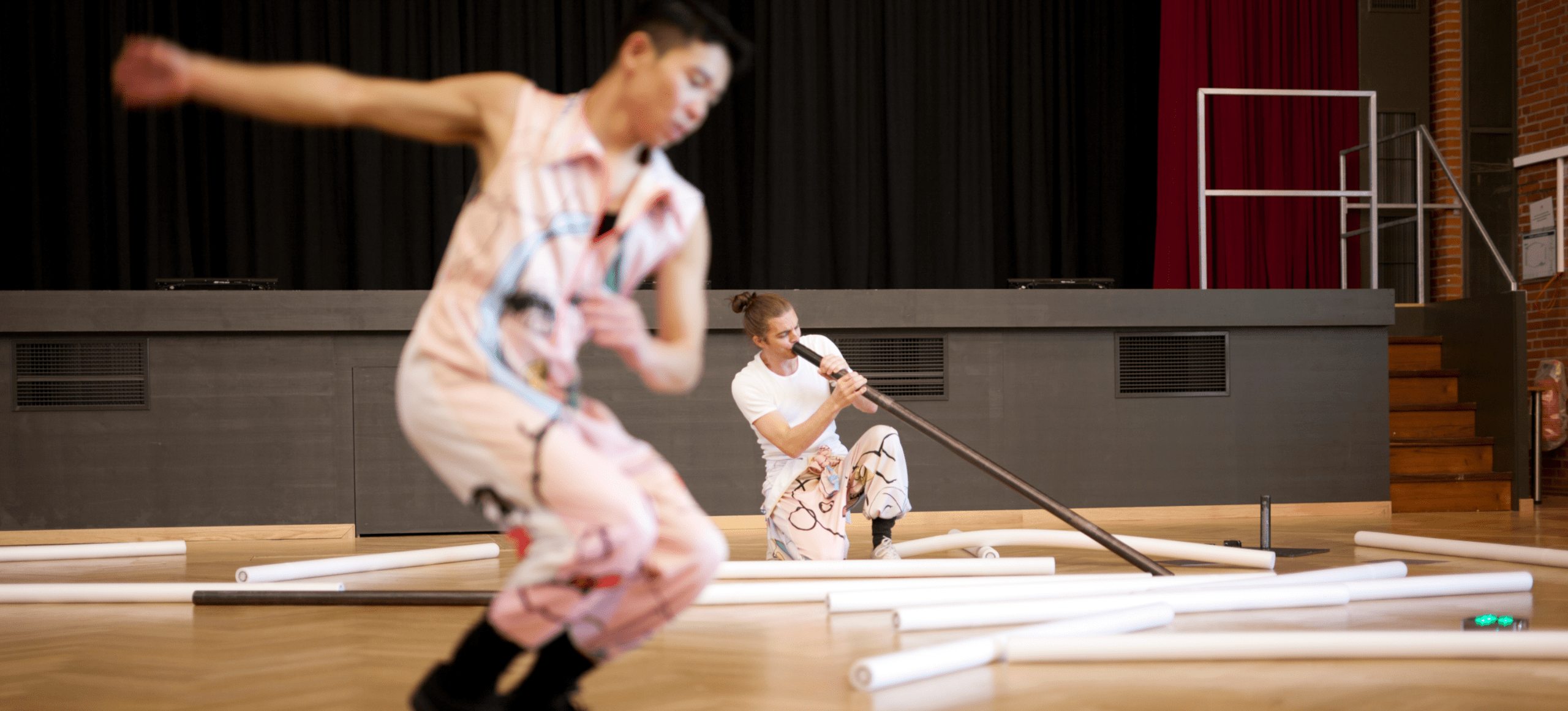
THE ESSENCE OF THE KISS
RAYMOND LIEW JIN PIN & JASCHA VIEHSTÄDT: 1000 KISSES
What is the essence of the kiss? Does the partner become alien in the repetition? In 1000 KISSES, the two choreographers and dancers Raymond Liew Jin Pin and Jascha Viehstädt explore how the archetypal gesture of the kiss changes when its emotionality is put into perspective by counting. The science journalist Dr Stephanie Maeck met the two in Hamburg for a workshop talk.
By Dr. Stephanie Maeck | 29. April 2022
Explore dance: Jascha and Raymond, you kissed each other thousands of times while rehearsing for your performance 1000 Kisses – do you feel that you better understand the kiss now, or did it become even more mysterious to you in the process?
Jascha: With our work we were looking for the uber-kiss, so to speak, something like the essence of the kiss. The result was meant to show: what is that, a kiss? To do so, we broke the kiss apart into individual moments. We wove in references to rituals and states of trance as well as religious moments. Ultimately, many small associations emerged. Many in the student audience nevertheless developed ideas that surprised us. What was remarkable to me was that for us as dancers the kiss became abstract at some point – it was no longer linked to a romantic gesture or way of greeting, but became a ‘dance kiss’, comparable to any other movement, such as lifting the leg. During the first days of rehearsal, kissing was still an emotionally stirring experience, but later it came to resemble all other movements.
Raymond: Another factor in the rehearsal process is that we’re also a couple in our private lives. If two choreographers were to work together who were not a couple, it would probably lead to a different perspective. Our dance is always informed to some degree by our private life – after a show, for example, a student asked us if the piece dealt with our love relationship. Maybe – but above all, we see the kiss as a type of movement.
On stage, you use repetition as a stylistic device. What happens to the body when you repeat a kiss so many times?
Raymond: During the performance we count, and the repetition thus becomes obvious. For me as a dancer, this process conjures up a variety of images and emotions, which we then work with during the performance. The desire to kiss someone, or the expectation of being kissed momentarily, are linked to many facets of feelings: The body gets into a state of expectation.
Jascha: As performers, we’re used to exposing ourselves on stage. The repetition of movements creates a certain state of being that we then use as a point of departure. In this state, images and associations emerge that we then connect.
Does the kissing partner also become strange or unfamiliar in the repetition?
Raymond: The more I repeat a movement, the more I understand it, and so both the kiss and my counterpart became much clearer to me in the process. When kissing, I noticed many things – the wetness of the lips, the other’s smell, becoming ever more detailed in its sensuality. And one wondered, why do people actually do that: kiss one another?
A central question: When you develop a performance, do you work analytically or intuitively?
Jascha: For 1000 Kisses, we had quite a long preparation phase in which we approached the kiss conceptually and also took a bit of theory into account. Usually we extract the structure from a basic idea and look for images to go with it. This gives us security: we hope for intuitive and automatic processes in the process, aided by that stabilizing structure. In this case, we had the idea to count: After all, counting also draws the audience along; as it progresses, one adopts a more analytical perspective and looks at the kiss in a more distanced way. Counting thus changes the meaning of kissing – as sometimes happens between two people as well. When people kiss, other thoughts are sometimes involved: taking care of the children, household chores, being distracted by cell phones. In the same way, counting puts the emotionality of the kiss into perspective.
In the brain, counting targets the center for rational-logical thinking, whereas movement rather comes from the area of emotionality and intuition. Is it difficult to bring the two together on stage?
Jascha: Actually, this challenge has become noticeable. Normally I don’t speak as much on stage. I use the numbers in this piece to support my work. During the first rehearsals we miscounted wildly, sometimes jumping back 100 counts without even realizing it.
Raymond, as part of your background you bring along many different cultural dance techniques. Does a lot of that flow into 1000 Kisses?
Raymond: In our previous piece, I actually worked consciously with references to traditional Chinese, Indian, or Malaysian dance. For 1000 Kisses, I put more trust into my embodiment in the concrete situation: what movement is needed on stage? Then I perform it.
For the stage set you use pool noodles, and sometimes the work with them seems almost sculptural, for instance when they morph into a tree with branches on stage.
Jascha: When K3 asked us to contribute a performance, we wanted to present conceptual dance and include visual art. So we asked Balz Isler for stage and media use and Signe Koefoed for costumes. Balz Isler has worked a lot in performance sculpture. The stage design was meant to resemble a sculpture and be able to stand on its own. At the same time, we want it to create a free space for associations. At a certain point, pieces develop a life of their own: The tree made of pool noodles creates a space for associations. The students had so many ideas about this that didn’t even occur to us: What does it mean when you’re in the tree and you snap off the individual branches? One student saw society’s expectations of homosexual couples in the branches and suggested that we may symbolically rid ourselves of these conventions when we throw the branches to the ground.
Does such audience feedback inspire you?
Raymond: The feedback is valuable, and it’s nice to rediscover our piece through the eyes of young viewers. You realize: the performance is fluid, in its meanings as well. For us, it was the first play for a younger audience, so we spent quite some time thinking about what we could presuppose in terms of experiences and viewing habits. Therefore, we also provide a small reading guide as an intro.
Your piece moves among echoes of a Western hypersexualization, but in places is also downright meditative and dreamy. What did you want to tell?
Jascha: When two men kiss on stage, it calls up sexualized contexts – that’s why we deliberately don’t go any further. When we lie down on the pool noodles, for example, there is a gasp in the young audience every time: Are they going to take their clothes off now? We hint at rather than actually show the sexuality of the kiss. In Asian culture, the kiss has a dreamy, romantic side that we also address in our production.
Raymond: One teacher noted that some students have grown up watching pornography on the Internet, but that when it comes to watching people kiss, some of them can hardly stand to look. Young people are indeed very used to digital worlds, but the direct staging also arouses shame. Although young people have so many ways to find information on the topic, they are quite insecure today. There is a lot of pressure to kiss well, even this area they are still trying to optimize like the pictures on Instagram. To feel the resonance of the young people, for example their giggling in the stage space, is very important for each individual performance.
Is every single performance unique?
Jascha: Our creative intention is always the same, but what emerges is new and exciting every time. When we play in front of students, the reaction is more direct than with adults: The actuality of the day flows into it every time. One day, the students were supposed to go to an anti-war demonstration immediately afterwards. Even on stage, I was thinking: We’re dealing with Russia’s war of aggression in Ukraine – what does it mean to see and perform this play now? 1000 Kisses deals so directly with the issues of gender and sexuality, since two men are kissing on stage, that on that day it became a play about freedom in society and about the limits of what one is allowed to express and what not.
Before the war we were dealing with Covid, and we’re still experiencing many restrictions due to the pandemic. What did it mean to produce such an intimate and physical piece in this time of being out of touch?
Jascha: Interestingly, our audience never addressed the pandemic in the conversations afterward. The topic was less pressing for us as well. We simply felt the need to do the piece. We just didn’t know in the preparation whether we would have to wear masks during the performance. That would have been a challenge. Fortunately, it all worked out fine. I think it’s nice that the piece is so physical – maybe it brings back some of the things we’ve lost in the last two years.
Your performance really is very physical, almost haptic. Did you find any inspiration in art history? Your work reminds me of Marina Abramovic’s. She too delivers herself physically in an extreme way, for instance in performances like The Artist Is Present – kissing each other a thousand times seems similarly demanding.
Jascha: In fact, the kiss we do with sound in our mouths is an homage to a performance by Marina Abramovic, in which the performers breathe in and out of each other until they faint. We wanted to show the confrontation of two bodies, and not just depict the tenderness of the kiss. There is violence in the kiss as well. We also incorporated echoes of German Expressionism in the dance. We call the scene The German Witch, thinking of Mary Wigman and her Witch Dance, which is very expressionistic and moves between dance and performing arts. One moment is inspired by the piece Café Müller by Pina Bausch: a scene where we repeat and vary movements in quick succession. We wanted to weave these references into the piece like taste impulses, so that the students might rediscover these flavors later when they encounter them as adults.
Was it easier to develop this intimacy because you are a couple?
Jascha: It definitely would have been a different piece, probably with a different idea, if we weren’t in a relationship. I think it definitely helps the idea of the piece that we are two men, because it opens up a certain space. I would still like to develop a version for a man and a woman or two women.
Raymond: My next piece will be about LGBTQ issues in Malaysia. In Malaysia, it would be hard to imagine two men kissing on stage. In the future, I do want to use the performances to advocate and work for more openness on gender issues.
Do you see yourselves as political artists?
Raymond: We are turning into political artists! We’re being politicized by everything that is happening in the world right now. During the pandemic, we couldn’t enter my home country of Malaysia as a married couple because marriage between men is forbidden, so Jascha wasn’t considered my family.
That’s not in keeping with the times at all! But besides calling for greater openness on gender issues, what else have you found out about kissing?
Jascha: While working on the play, I read a study on which cultures klink kissing and romance, and apparently only about 60 percent do so. In the study, this was attributed to the amount of clothing on the body. The thesis was that the less clothing people have on their bodies, the less they kiss because physical intimacy already exists. To me, this relates a lot to dance. Many tropical indigenous peoples don’t kiss at all because they are barely clothed in the eternal summer. The Inuit, on the other hand, are completely covered and only have their faces exposed – they do kiss. Kissing seems to be a focus on physical closeness: Where there are social conventions or clothing, it’s a way of getting closer, like holding hands. In more distanced societies, it allows proximity to be re-established. It is an archaic connection to our origins and allows us to connect with our human nature.
In a sense, a connection to our archaic roots. Do we then also need more kisses in these politically challenging times? Is the kiss also a gesture of peace among people and nations, globally?
Jascha: We believe that kissing can symbolize peace, but it can also mean the opposite, that is, it can be violent and encroaching. It’s not only a romantic gesture of peace; it can create suffering as well. It’s about people influencing each other and the impact of our mutual interactions, as friends or as enemies? I would like 1000 Kisses to see students discuss all these important questions about being human through.















